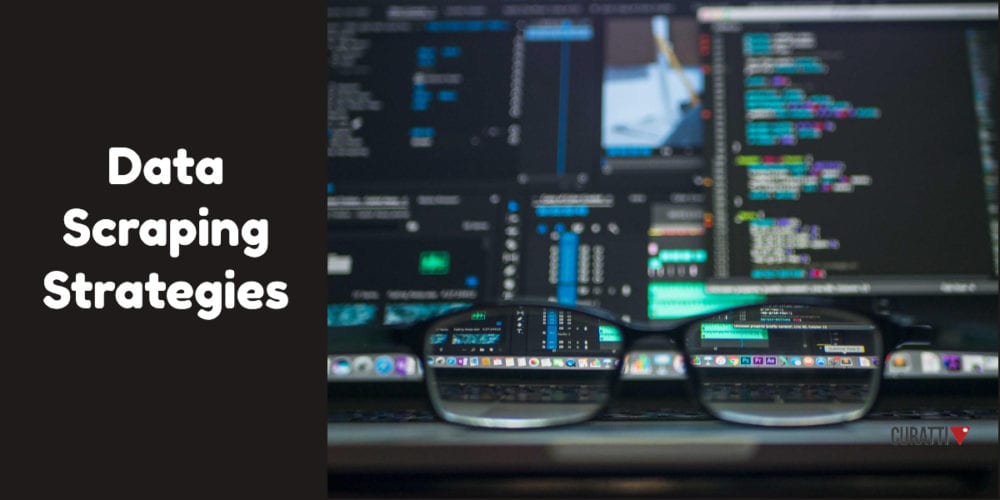Effective Data Scraping Strategies and Resources for Digital Marketers

Data scraping is not a new practice. It pre-dates the internet and existed even before data mining was much of a concept. From a marketing perspective, it began long before manual copying and pasting. Relevant company information got copied with pen and paper. These days, bots do the work for us and have a superior success rate.
The concept of data scraping has been on shaky ground regarding legal concerns. Thanks to the settlement in the early 2000s with eBay vs. Bidder’s Edge, companies can still take accessible website information. Obviously, this can’t extend to hacking to steal private information.
Data scraping, web crawling, data extracting, screen scraping or similarly-named activities, are still legal and easy to do. Here are just a few strategies to consider:
- Competitive Monitoring
- Content Aggregation
- Sentiment Analysis
- Machine Learning
1. Competitive Monitoring
Competitive monitoring, or competitor analysis, is central to data scraping. You have to learn what competitors already know and then some. Markets like real estate depend on data scraping to make informed decisions. Using data scraping to keep track of the details gives you valuable information to keep you ahead.
A real estate investor in Budapest used a service that allowed extracting data directly from a real estate site. This included:
- Monthly rent and sales prices
- The property’s district
- Whether the property had furniture in it.
Most important from a competitive standpoint, was that the data scraping tool extracted the view counts for each property.
Of course, competitors can do the same thing to you. That means remaining vigilant in this landscape is challenging. Data scraping techniques can help everyone. Success comes down to who, if anyone, utilizes it better. Knowing how your competitor’s customers act helps you handle your own and win more people over.
It’s also crucial to determine whether data scraping could help you retrieve data that your competitors might miss. In real estate, you might check to see if websites showed a property on the market recently. The scraped information could also detail the circumstances of the eventual sale.
When data scraping for competitive monitoring, consider Scraper API, or any proxy service, to reroute your IP address. If a website realizes you’re scraping the site owner’s data, it may prevent your address from obtaining publicly available information.
Competitor monitoring data scraping tools are available for free. When or if you find that the website has blocked a proxy you were using, you can simply move on to another one.
2. Content Aggregation
Another great use of data scraping is getting to know your audience on a whole other level. You can see what people say about you, your product and your competitors’ products by examining the right data points. You can also boost your content by using the collected data in the right way. Writer Mathew Barby got his BuzzFeed article on the front page and viewed over 100,000 times by using data scraping.
He gathered concrete data instead of going with his instinct about what to post and when. First, he collected the names of blog contributors. Then, he went further by getting extra author details. Sometimes, that was as easy getting links to their social media profiles from author bios. Barby put all the scraped data into a spreadsheet. It ranked each author according to their social media follower accounts as well as the post date and time.
Before you produce content for a site, Barby recommends applying some of the data scraping strategies above. Determine which content types will get you the best results based on other author’s article views.
There’s more to the process than just monitoring other bloggers. But, collecting data on what, how and when the professionals write can help you grow beyond them.
After you know how content aggregation and data scraping fits into your strategy, learn to change and remove browser headings. They check for and block web scrapers. But, browser headings are alterable with codes you can manipulate.
Alternatively, opt for a headless browser. This technique’s a little trickier, but it pays off by scraping web destinations like social media sites. The aforementioned Scraper API can do this for you. A headless browser can be difficult but not impossible to achieve. Once you have it, you’ll practically be unstoppable.
3. Sentiment Analysis
Product-based content seems easy to manage, but actual reviews and customer feedback can be challenging to source. Genuine customer feedback is instrumental in helping you understand which characteristics of a product or service make customers embrace it. You’ll also learn the things that frustrate them. A lot of reviews don’t make it to review sites, though.
Some consumers are so eager to share their good and bad experiences that they don’t want to sign up for accounts at review sites. Instead, people post honest opinions about products to social media. Engaging with social media and tracking your product mentions can inform you of what customers want.
Monitoring people’s opinions like this is called sentiment analysis. You can excel at it with the help of data scraping. Begin by collecting positive and negative reviews. Then, separate them into two categories and determine the common threads between the people who are satisfied or dissatisfied.
Most reviewers have both good and bad things to say. If you import your scraped data into a spreadsheet program, consider color-coding the sentiments. You might highlight the positive sentiments in green, the negative ones in orange and the neutral ones in yellow. If reviews detail areas for improvement, dedicate a color to those mentions.
Always use a real user agent instead of the fake one that comes with most web scrapers. The user agent is a string that tells the server about the device you’re using to access the website. Some sites block user agents that don’t belong to major browsers to prevent hacks and stolen information.
Fortunately, it’s easy to use a real user agent instead of a fake one. Set one up with Googlebot User Agent. It’s reliable and well-known enough not to raise eyebrows.
4. Machine Learning
Artificial intelligence, or machine learning, has a lot to give and take concerning data scraping. For one, using bots with AI installed can make the process easier since they do the job for you. Once the bot knows what you want, it goes across the internet and finds the relevant information without you intervening. Machine learning isn’t so much a strategy for screen scraping. However, it’s a strategy used for the same process as a related option.
Besides, bots wouldn’t know where to go without data scraping coming first. They find where the relevant data is because the information told them. Thanks to data, bots can travel across the internet to gather more and create a stronger, wider network of information. Now, practically the whole data collection system is automated due to bots.
Are you not sure if you’re ready to use machine learning for data scraping? No problem. You can still simplify the process by choosing an all-in-one web scraping tool that does the heavy lifting for you. For example, Import.io is a web scraper that requires no extra coding or add-ons. Everything you need already exists, or the tool has the means to implement your data scraping plans. A tool like this could offer cost savings and gather data much faster than before with less labor.
The downside of getting a web scraper like this is that you didn’t build it yourself. These tools may be very customizable. However, you won’t know the ins and outs as well as if you created one from the ground up. Even so, web scrapers like Import.io are fantastic if you’ve never worked with one before and want to learn more.
The Ever-Transforming Field of Data Collection
As technology and security improve, hacking gets better, too. Malicious hacking is what companies want to protect themselves from. But, their safeguards, unfortunately, catch you in the crossfire most of the time. Thankfully, data scraping is a legitimate practice for information collection and digital marketing. Remember, the act itself isn’t bad, just increasingly difficult.
As hacking becomes enhanced and more involved, the ruling on eBay vs. Bidder’s Edge could change soon. For now, technology will continue to increase company efficiency in every form. While you’re scraping the competitors, they’re doing the same to you. Don’t make information public that competitors shouldn’t see. Otherwise, you might end up playing with fire and getting burned.
 Kayla Matthews is a digital marketing journalist who has written for Contently, Convince and Convert, Inc.com and more. To read more by Kayla, follow her on Twitter @KaylaEMatthews.
Kayla Matthews is a digital marketing journalist who has written for Contently, Convince and Convert, Inc.com and more. To read more by Kayla, follow her on Twitter @KaylaEMatthews.
Featured image: https://www.pexels.com/photo/coding-computer-data-depth-of-field-577585/

CURATTI GUEST


